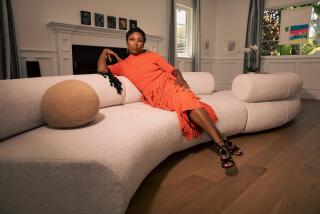Tiaras Anyone?
- Share via
Somewhere between the no-nonsense feminism of Ms. and the instructional sluttishness of Cosmo lies Princess, a creation of New York zinester Francesca Castagnoli.
Barrette reviews, shoe haikus, a guide to Hello Kitty paraphernalia and an essay on tiaras all appeared in Castagnoli’s first self-published issue two summers ago.
“I loved [the teen mag] Sassy and then it died, which was probably a great thing because it motivated me to do Princess,” says the 27-year-old. “I [decided] to create my own magazine because there wasn’t anything that was speaking to me as a woman.”
A self-identified feminist who likes her lipstick red and her clothes funky, Castagnoli is part of a sub-subculture in the zine world that approaches “women’s issues” with humor. Like the better-known Bust, Princess is a reaction to those fat glossies telling readers how to look, act, eat and feel (horrible about themselves).
While Vogue would have us believe that Claudia Schiffer’s measurements are perfectly normal, Castagnoli (at a mere 5 feet, 2 inches and 125 pounds) recognizes a 36-22-38 figure for what it is--a freak of nature. Instead of diet tips, Princess offers junk-food reviews. Its retro advertising is clipped straight from fashion mags of the ‘60s, a decade that gave birth to the twin Princess tenets of feminism and Mod fashion.
“The word ‘princess’ is a reflection on wanting everything without having to make excuses [about it]. I wanted to show that you can be intellectual, and you can still wear makeup and be married and be taken seriously as a woman,” Castagnoli explains. “I knew that if I was going to do something that was speaking to me and that was about me, it had to talk about clothes and beauty and fashion and . . . empowerment.”
Given a Catholic upbringing on Long Island, Castagnoli attended a Christian boarding school where, she says, “[Everyone] prayed before geometry. [It was] a horrible situation and did a number on me, but that was where I learned to question ideas.”
From there she landed at a women’s college in Boston, then moved to San Francisco. While working as a copywriter for a direct-marketing firm, she started Princess. “The benefit of a very dry job is that it makes you want to define yourself in other ways,” she says.
Though Castagnoli had definite ideas about what sort of zine she wanted, and an army of friends eager to collaborate, Princess wasn’t always a Cinderella. Entering the zine world at the height of the grunge-inspired riot grrrl movement, Castagnoli felt like the odd woman out.
“I had this tremendous anxiety about Princess being too fluffy--about it being a little zine about where to go shopping. So many of these magazines were saying, ‘I’m angry. I’m a lesbian.’ There was nothing wrong with that, but I didn’t ID with it. Princess . . . was a way to say, ‘These are my ideas. If you think they’re interesting, great. If not, don’t read it.’ ”
Compared to the sloppy, photocopy-and-staple jobs that pass for most zines, the design of Princess is clean, its covers imaginative. “I’m not a cut-and-paste, slap-it-together, messy kind of girl,” Castagnoli says. “I knew, with that name, it had to look gorgeous.”
In July 1995, Princess made its debut. After a favorable review in Fact Sheet 5, a zine that critiques other zines, Castagnoli quickly sold out of her 200 copies; Princess’ playful subtitle--”You Know Who You Are”--apparently hit home. Unfortunately, the publisher also made the beginner’s mistake of charging only $2 when the postage alone cost $2.40.
With double the page count and print run for the second issue in November that year, Princess had another favorable Fact Sheet 5 review and again sold out.
The third installment, priced at $3 and due out next month after a hiatus Castagnoli attributes to a demanding day job as an editorial assistant at Details magazine, features a review of bite-sized cookies, a history of perfume, an essay by cartoonist Amy Davis and “Interview With a Vampire,” Castagnoli’s first-person account of job hunting in New York. Exploring their feminine sides are a few men as well: Chris Arnold, a National Public Radio reporter, and David Moore, Castagnoli’s fiance and a minimalist poet who, she says, “is single-handedly trying to bring back the haiku.”
As befits a princess, Castagnoli now lives with Moore on Park Avenue, where she enjoys the rare convenience of having a landlord she calls Dad. But, Castagnoli is careful to point out, she has never been daddy’s little girl. “If anyone inspires me to be fashionable or beautiful or elegant, it’s my mother. She has a very definite sense of her style and [of] herself.”
Acknowledging the achievements of her mother’s generation, she says, “Women right now are really fortunate to have everything they do. Our mothers would say we have a better sense of ourselves than they did. Women who are 15 and 16 right now have a better sense of themselves than we did. Feminism has changed. That’s the core of it.”
Picking up where Sassy left off and aiming for a slightly older audience, Castagnoli has high hopes for her little Princess. “[Publishing] is the ultimate way of communicating big ideas to a mass audience. I hope to eventually be in a situation where I speak to a generation of women who . . . are happy with who they are, who make demands and who see what they think is important fulfilled no matter what, whether it’s decorating, bungee-jumping or skateboarding.
“The only way I can find satisfaction in myself is through accomplishment, and I think there are a lot of young women who feel the same way.”
* Interested readers may write to Princess, 175 Fifth Ave., Suite 2416, New York, NY 10010. The e-mail address is P[email protected].






